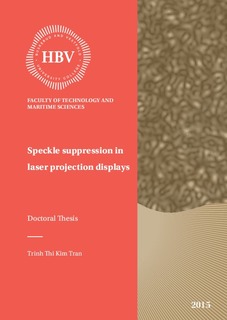| dc.contributor.author | Tran, Trinh Thi Kim | |
| dc.date.accessioned | 2015-06-30T06:34:58Z | |
| dc.date.available | 2015-06-30T06:34:58Z | |
| dc.date.issued | 2015 | |
| dc.identifier.isbn | 978-82-7860-255-3 | |
| dc.identifier.issn | 1894-7530 | |
| dc.identifier.uri | http://hdl.handle.net/11250/286023 | |
| dc.description.abstract | Laser light source becomes more popular today in the projection technology. The use of lasers in projection applications provides considerable advantages compared to conventional projection lamps. These are, for example, long lifetime, large color gamut, small étendue for small projection system. However, one of a major obstacles that prevents lasers projection from the market is speckle. Speckle appears as unwanted granular noise on projected images and it degrades the image quality. A number of speckle reduction solutions have been developed in recent years. However, speckle removal methods that can be integrated in laser projection technology are still challenging. The objective of this PhD work is the investigation, application and characterization of methods for speckle suppression in a real laser projection system.
Different approaches for speckle suppression are examined in this work. The first approach is the application of a Microelectromechanical systems (MEMS) diffuser. The benefits of using MEMS diffuser are: less power consumption, small size, simple drive electronics, and simplified integration within a projector. The MEMS diffuser has random patterns that have a role as wavefront phase modulator for speckle suppression. The device is designed based on Silicon on Insulator (SOI) MEMS fabrication process. The design of MEMS diffuser is then theoretical calculated and simulated. The experimental dynamic measurement of MEMS diffuser shows a well fit with the calculation and simulation results. Speckle contrast suppression of the diffuser is characterized. The device provides up to 43:8% of speckle suppression. Based on the same principle, a second generation of MEMS diffuser is designed to have larger height fluctuations with a continuous profile. The calculation, simulation and characterization of the second generation MEMS diffuser are done. However, due to the properties of fabrication processes, a continuous profile of random patterns can not be attained and therefore the second generation of MEMS diffuser does not offer better speckle suppression.
The second approach for speckle suppression is a commercial phase-randomizing deformable mirror for anti-speckle technology. The mirror can tolerate high optical power thus it is suitable for laser projection system where high power lasers are required. The mirror comprises a continuous surface of micro mirror array that can be individually deformed and actuated up to hundreds of kHz. Due to the deformation of the micro mirrors, speckle contrast is reduced by the introduction of angle diversity. Speckle suppression by combination of wavelength diversity and angle diversity is measured and analyzed. The study is done both for single broadband laser and laser array. It is shown experimentally that speckle contrast can be reduced down to 0.04 for single broadband laser and to 0.033 for four broadband lasers array.
Finally, different speckle suppression methods such as wavelength diversity, angle diversity, moving diffuser are applied in a real laser projection system which is built by Projectiondesign AS. Speckle contrast of the projected images is characterized by setting the camera to match speckle perception of human eyes. Speckle contrast of 0.050 and of 0.038 are attained respectively for red lasers and blue lasers in the projection system. | nb_NO |
| dc.language.iso | eng | nb_NO |
| dc.relation.ispartofseries | Doctoral theses at Buskerud and Vestfold University College;4 | |
| dc.relation.haspart | 1: Thi-Kim-Trinh Tran, S., Subramaniam, S., Cuong-Phu Le, S., Kaur, M., Kalicinski, E., Ekwinska, M.N., . . . Akram, M.N. (2014). Design, modeling, and characterization of a microelectromechanical diffuser device for laser speckle reduction. Journal of Microelectromechanical Systems, 23(1), 117-127. doi: 10.1109/JMEMS.2013.2262598 (Published online 3. July 2013) | nb_NO |
| dc.relation.haspart | 2: Tran, T.-K.-T., Chen, X., Svensen, O., & Akram, M.N. (2014). Speckle reduction in laser projection using a dynamic deformable mirror. Optics Express, 22(9), 11152-11166. doi: 10.1364/OE.22.011152 | nb_NO |
| dc.relation.haspart | 3: Tran, T.T.K., Chen, X., Svensen, Ø., & Akram, M.N. (n.d.). Speckle reduction in laser projection display through angle diversity and wavelength diversity. (Draft) | nb_NO |
| dc.relation.haspart | Conference paper 1: Tran Thi, K. T., Tong, Z., & Akram, M. N. (2012). Speckle reduction characterization of high power broad-area edge-emitting diodes lasers. Paper presented at the Specle 2012: V International conference on speckle metrology, Spain, 2012. Proceedings of SPIE - The International Society for Optical Engineering, vol 8413, article no 84131N. Retrieved from http://www.scopus.com | nb_NO |
| dc.relation.haspart | Conference paper 2: Tran, T. K. T., Chen, X., Svensen, O., & Nadeem Akram, M. (2013). Demonstration of speckle reduction in a laser projector by micro-electro-mechanical diffuser device. Paper presented at the Frontiers in Optics, FIO, Orlando, 2013. Optics InfoBase Conference Papers, FM4F.5. Retrieved from www.scopus.com | nb_NO |
| dc.relation.haspart | Conference paper 3: M. N. Akram, T.T.K. Tran and X. Chen. (2014) A survey of speckle reduction methods in laser based picture projectors. International Conference on Optoelectronic Technology and Application (SPIE). | nb_NO |
| dc.relation.haspart | Conference paper 4: Svensen, Ø., Akram, M. N., Tran, T.-K.-T., & Chen, X. (2014). Design Aspects for High Lumen DLP Laser/phosphor Projector. Paper presented at the International Optical Design Conference, Kohala Coast, Hawaii United States. | nb_NO |
| dc.subject | laserprojeksjon | nb_NO |
| dc.title | Speckle suppression in laser projection displays | nb_NO |
| dc.type | Doctoral thesis | nb_NO |
| dc.source.pagenumber | 84 | nb_NO |
